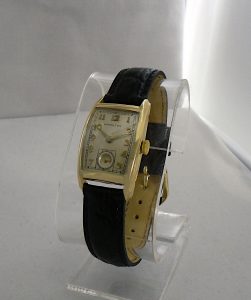
I find it doubtful many of these watches still exist and they are highly collectible. Why? Hamilton scheduled the release of this watch in 1942. The company had to suspend production due to World War II and the War Powers Act.
I can understand Hamilton Watch Company planning for the release of new product for 1942 before anyone knew about the attack on Pearle Harbor. Before the watch could go to market, President Franklin D. Roosevelt placed the country under the War Powers Act and forbid Hamilton to make consumer products. I have never seen a 1942 Hamilton catalog, so like other collectors, I couldn’t identify this watch. Someone else told me about it.
I like the “Alan” and believe it would have gained popularity. It has a “curved to the wrist” case, a Butler finish dial with 18K gold detachable numerals and hands, a sunken second hand dial and though they came with a 980 movement, this one has a 982 caliber movement. It reminds me of a Boulton, a little smaller with a Sutton style curved case.
Hamilton’s internal design department collaborated with Wadsworth and the independent design firm of DiVincenzo & Arienti of New York for many of its model designs. Since this watch with a Keystone case has me guessing as to who designed it and when.
Back in 1936, management tasked the design department to create a line of watches to appeal to buyers with a moderately affordable product. Hamilton felt that a better than “Elgin” watch would catch the publics attention. The prototype Alan met the expectation, but the 980 movement cost too much to give Hamilton the profit margin they needed.
In 1936, Franklin Roosevelt assured the nation that the economy had emerged from the depression and as a result many manufacturers began hiring and creating inventory. In 1937, the country fell back into a major recession. Instead of offering moderately priced watches with 14/0 size, 19 jewel 982 movements, the Hamilton switched to less expensive cases and 17 jewel 987A movements.
Hamilton’s use of the Elinvar alloy made their movements technically superior to both domestic and international competitors. The alloy allowed their watches to keep accurate time regardless of fluctuations in temperature and, or altitude. In addition, Hamilton equipped the 982 with materials that allowed watchmakers to tune them to chronometer status.
I found this Alan in mint condition. You can tell by close examination of the photos. Notice the case back, movement, dial and lack of wear.
This watch will seem small by today’s standards. I have heard perfectly normal people tell me 1930 model Hamilton’s are women’s watches. If that’s so, then a lot of Rolex watches fit that same gender. Actually, the move to large watches started in the mid-2000’s. Tank style watches became popular in the 1920’s and remained that way even now. Just don’t tell people who have no experience with history.
Summary of this model:
Hamilton 1942 gold filled men’s watch
Keystone 10K Case
New Crystal: Mineral Shatter proof, scratch resistant
Hamilton 982 19 Jewel hand wound movement completely restored
Soft leather band
Excellent to mint condition
Brand: Hamilton
Case: 23 mm x 38 mm lug to lug
Clasp: Buckle
Water Resistance: Not water resistant
Lug Width: 15 mm
Country of Origin: USA
Watch industry insiders and critics consider Hamilton’s Art Deco watches from the 1930’s as the finest wind-up mechanical watches ever made. The 982 movement originated in the 1930’s. It has precious medal plates, real jewels, no wear on the pivots and the alloy materials allows it to keep time regardless of altitude or temperature.
